Zhaonan Wang
Adaptive and Iterative Point Cloud Denoising with Score-Based Diffusion Model
Sep 18, 2025Abstract:Point cloud denoising task aims to recover the clean point cloud from the scanned data coupled with different levels or patterns of noise. The recent state-of-the-art methods often train deep neural networks to update the point locations towards the clean point cloud, and empirically repeat the denoising process several times in order to obtain the denoised results. It is not clear how to efficiently arrange the iterative denoising processes to deal with different levels or patterns of noise. In this paper, we propose an adaptive and iterative point cloud denoising method based on the score-based diffusion model. For a given noisy point cloud, we first estimate the noise variation and determine an adaptive denoising schedule with appropriate step sizes, then invoke the trained network iteratively to update point clouds following the adaptive schedule. To facilitate this adaptive and iterative denoising process, we design the network architecture and a two-stage sampling strategy for the network training to enable feature fusion and gradient fusion for iterative denoising. Compared to the state-of-the-art point cloud denoising methods, our approach obtains clean and smooth denoised point clouds, while preserving the shape boundary and details better. Our results not only outperform the other methods both qualitatively and quantitatively, but also are preferable on the synthetic dataset with different patterns of noises, as well as the real-scanned dataset.
Deep Learning and Foundation Models for Weather Prediction: A Survey
Jan 12, 2025Abstract:Physics-based numerical models have been the bedrock of atmospheric sciences for decades, offering robust solutions but often at the cost of significant computational resources. Deep learning (DL) models have emerged as powerful tools in meteorology, capable of analyzing complex weather and climate data by learning intricate dependencies and providing rapid predictions once trained. While these models demonstrate promising performance in weather prediction, often surpassing traditional physics-based methods, they still face critical challenges. This paper presents a comprehensive survey of recent deep learning and foundation models for weather prediction. We propose a taxonomy to classify existing models based on their training paradigms: deterministic predictive learning, probabilistic generative learning, and pre-training and fine-tuning. For each paradigm, we delve into the underlying model architectures, address major challenges, offer key insights, and propose targeted directions for future research. Furthermore, we explore real-world applications of these methods and provide a curated summary of open-source code repositories and widely used datasets, aiming to bridge research advancements with practical implementations while fostering open and trustworthy scientific practices in adopting cutting-edge artificial intelligence for weather prediction. The related sources are available at https://github.com/JimengShi/ DL-Foundation-Models-Weather.
DG-Mamba: Robust and Efficient Dynamic Graph Structure Learning with Selective State Space Models
Dec 11, 2024



Abstract:Dynamic graphs exhibit intertwined spatio-temporal evolutionary patterns, widely existing in the real world. Nevertheless, the structure incompleteness, noise, and redundancy result in poor robustness for Dynamic Graph Neural Networks (DGNNs). Dynamic Graph Structure Learning (DGSL) offers a promising way to optimize graph structures. However, aside from encountering unacceptable quadratic complexity, it overly relies on heuristic priors, making it hard to discover underlying predictive patterns. How to efficiently refine the dynamic structures, capture intrinsic dependencies, and learn robust representations, remains under-explored. In this work, we propose the novel DG-Mamba, a robust and efficient Dynamic Graph structure learning framework with the Selective State Space Models (Mamba). To accelerate the spatio-temporal structure learning, we propose a kernelized dynamic message-passing operator that reduces the quadratic time complexity to linear. To capture global intrinsic dynamics, we establish the dynamic graph as a self-contained system with State Space Model. By discretizing the system states with the cross-snapshot graph adjacency, we enable the long-distance dependencies capturing with the selective snapshot scan. To endow learned dynamic structures more expressive with informativeness, we propose the self-supervised Principle of Relevant Information for DGSL to regularize the most relevant yet least redundant information, enhancing global robustness. Extensive experiments demonstrate the superiority of the robustness and efficiency of our DG-Mamba compared with the state-of-the-art baselines against adversarial attacks.
IGL-Bench: Establishing the Comprehensive Benchmark for Imbalanced Graph Learning
Jun 14, 2024Abstract:Deep graph learning has gained grand popularity over the past years due to its versatility and success in representing graph data across a wide range of domains. However, the pervasive issue of imbalanced graph data distributions, where certain parts exhibit disproportionally abundant data while others remain sparse, undermines the efficacy of conventional graph learning algorithms, leading to biased outcomes. To address this challenge, Imbalanced Graph Learning (IGL) has garnered substantial attention, enabling more balanced data distributions and better task performance. Despite the proliferation of IGL algorithms, the absence of consistent experimental protocols and fair performance comparisons pose a significant barrier to comprehending advancements in this field. To bridge this gap, we introduce IGL-Bench, a foundational comprehensive benchmark for imbalanced graph learning, embarking on 16 diverse graph datasets and 24 distinct IGL algorithms with uniform data processing and splitting strategies. Specifically, IGL-Bench systematically investigates state-of-the-art IGL algorithms in terms of effectiveness, robustness, and efficiency on node-level and graph-level tasks, with the scope of class-imbalance and topology-imbalance. Extensive experiments demonstrate the potential benefits of IGL algorithms on various imbalanced conditions, offering insights and opportunities in the IGL field. Further, we have developed an open-sourced and unified package to facilitate reproducible evaluation and inspire further innovative research, which is available at https://github.com/RingBDStack/IGL-Bench.
Graph Transformer Network for Flood Forecasting with Heterogeneous Covariates
Oct 11, 2023Abstract:Floods can be very destructive causing heavy damage to life, property, and livelihoods. Global climate change and the consequent sea-level rise have increased the occurrence of extreme weather events, resulting in elevated and frequent flood risk. Therefore, accurate and timely flood forecasting in coastal river systems is critical to facilitate good flood management. However, the computational tools currently used are either slow or inaccurate. In this paper, we propose a Flood prediction tool using Graph Transformer Network (FloodGTN) for river systems. More specifically, FloodGTN learns the spatio-temporal dependencies of water levels at different monitoring stations using Graph Neural Networks (GNNs) and an LSTM. It is currently implemented to consider external covariates such as rainfall, tide, and the settings of hydraulic structures (e.g., outflows of dams, gates, pumps, etc.) along the river. We use a Transformer to learn the attention given to external covariates in computing water levels. We apply the FloodGTN tool to data from the South Florida Water Management District, which manages a coastal area prone to frequent storms and hurricanes. Experimental results show that FloodGTN outperforms the physics-based model (HEC-RAS) by achieving higher accuracy with 70% improvement while speeding up run times by at least 500x.
MemDA: Forecasting Urban Time Series with Memory-based Drift Adaptation
Sep 25, 2023Abstract:Urban time series data forecasting featuring significant contributions to sustainable development is widely studied as an essential task of the smart city. However, with the dramatic and rapid changes in the world environment, the assumption that data obey Independent Identically Distribution is undermined by the subsequent changes in data distribution, known as concept drift, leading to weak replicability and transferability of the model over unseen data. To address the issue, previous approaches typically retrain the model, forcing it to fit the most recent observed data. However, retraining is problematic in that it leads to model lag, consumption of resources, and model re-invalidation, causing the drift problem to be not well solved in realistic scenarios. In this study, we propose a new urban time series prediction model for the concept drift problem, which encodes the drift by considering the periodicity in the data and makes on-the-fly adjustments to the model based on the drift using a meta-dynamic network. Experiments on real-world datasets show that our design significantly outperforms state-of-the-art methods and can be well generalized to existing prediction backbones by reducing their sensitivity to distribution changes.
MegaCRN: Meta-Graph Convolutional Recurrent Network for Spatio-Temporal Modeling
Dec 12, 2022

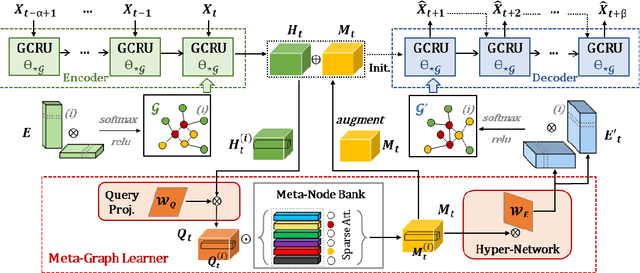
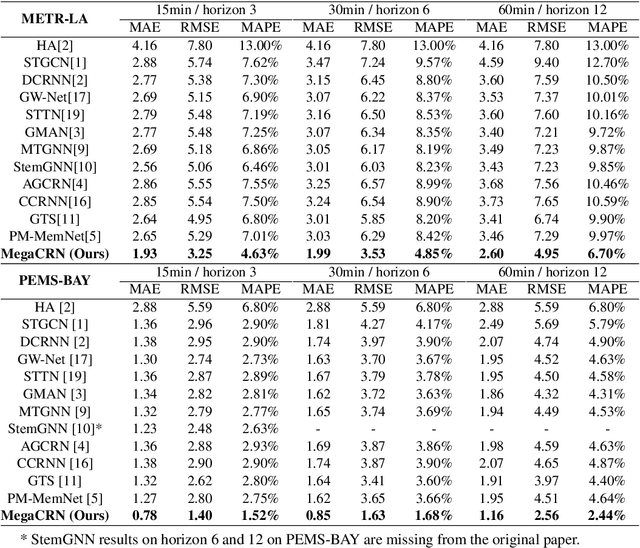
Abstract:Spatio-temporal modeling as a canonical task of multivariate time series forecasting has been a significant research topic in AI community. To address the underlying heterogeneity and non-stationarity implied in the graph streams, in this study, we propose Spatio-Temporal Meta-Graph Learning as a novel Graph Structure Learning mechanism on spatio-temporal data. Specifically, we implement this idea into Meta-Graph Convolutional Recurrent Network (MegaCRN) by plugging the Meta-Graph Learner powered by a Meta-Node Bank into GCRN encoder-decoder. We conduct a comprehensive evaluation on two benchmark datasets (METR-LA and PEMS-BAY) and a large-scale spatio-temporal dataset that contains a variaty of non-stationary phenomena. Our model outperformed the state-of-the-arts to a large degree on all three datasets (over 27% MAE and 34% RMSE). Besides, through a series of qualitative evaluations, we demonstrate that our model can explicitly disentangle locations and time slots with different patterns and be robustly adaptive to different anomalous situations. Codes and datasets are available at https://github.com/deepkashiwa20/MegaCRN.
Spatio-Temporal Meta-Graph Learning for Traffic Forecasting
Dec 08, 2022



Abstract:Traffic forecasting as a canonical task of multivariate time series forecasting has been a significant research topic in AI community. To address the spatio-temporal heterogeneity and non-stationarity implied in the traffic stream, in this study, we propose Spatio-Temporal Meta-Graph Learning as a novel Graph Structure Learning mechanism on spatio-temporal data. Specifically, we implement this idea into Meta-Graph Convolutional Recurrent Network (MegaCRN) by plugging the Meta-Graph Learner powered by a Meta-Node Bank into GCRN encoder-decoder. We conduct a comprehensive evaluation on two benchmark datasets (METR-LA and PEMS-BAY) and a new large-scale traffic speed dataset in which traffic incident information is contained. Our model outperformed the state-of-the-arts to a large degree on all three datasets (over 27% MAE and 34% RMSE). Besides, through a series of qualitative evaluations, we demonstrate that our model can explicitly disentangle the road links and time slots with different patterns and be robustly adaptive to any anomalous traffic situations. Codes and datasets are available at https://github.com/deepkashiwa20/MegaCRN.
Event-Aware Multimodal Mobility Nowcasting
Dec 14, 2021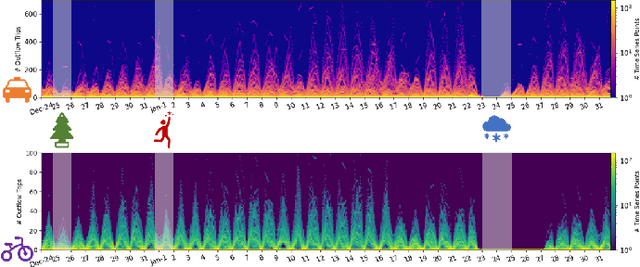

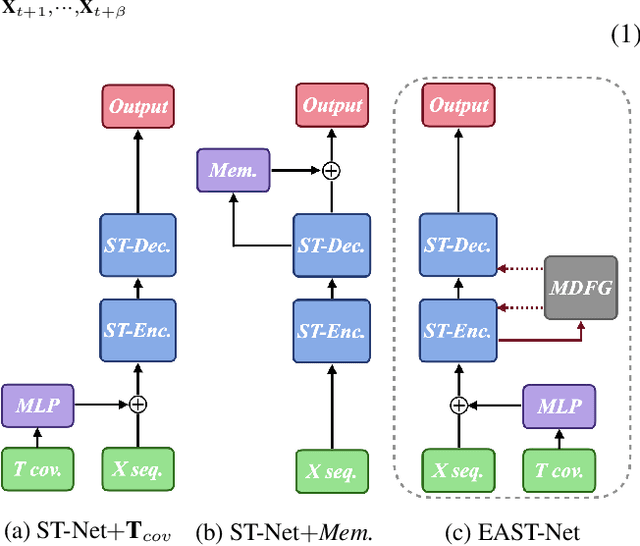

Abstract:As a decisive part in the success of Mobility-as-a-Service (MaaS), spatio-temporal predictive modeling for crowd movements is a challenging task particularly considering scenarios where societal events drive mobility behavior deviated from the normality. While tremendous progress has been made to model high-level spatio-temporal regularities with deep learning, most, if not all of the existing methods are neither aware of the dynamic interactions among multiple transport modes nor adaptive to unprecedented volatility brought by potential societal events. In this paper, we are therefore motivated to improve the canonical spatio-temporal network (ST-Net) from two perspectives: (1) design a heterogeneous mobility information network (HMIN) to explicitly represent intermodality in multimodal mobility; (2) propose a memory-augmented dynamic filter generator (MDFG) to generate sequence-specific parameters in an on-the-fly fashion for various scenarios. The enhanced event-aware spatio-temporal network, namely EAST-Net, is evaluated on several real-world datasets with a wide variety and coverage of societal events. Both quantitative and qualitative experimental results verify the superiority of our approach compared with the state-of-the-art baselines. Code and data are published on https://github.com/underdoc-wang/EAST-Net.
DL-Traff: Survey and Benchmark of Deep Learning Models for Urban Traffic Prediction
Aug 20, 2021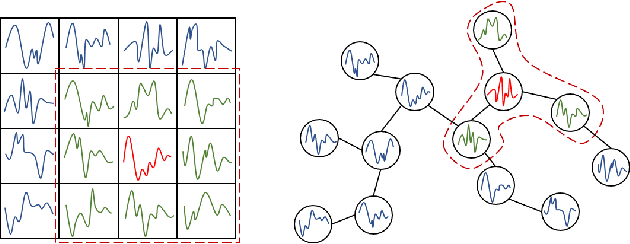
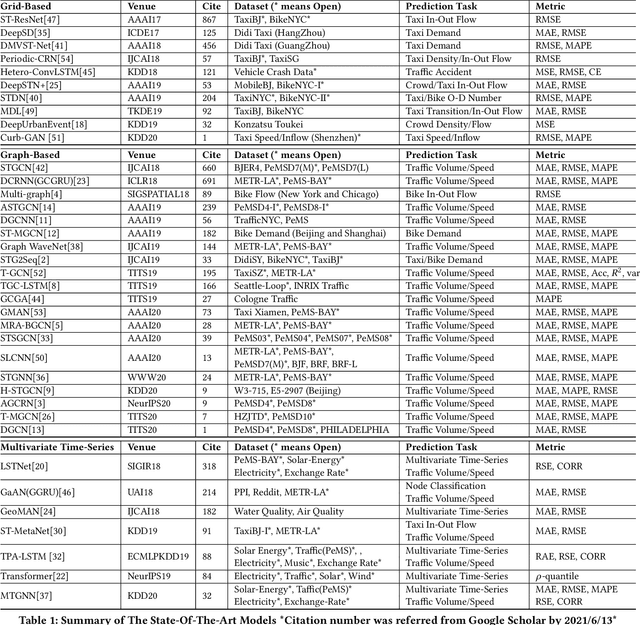

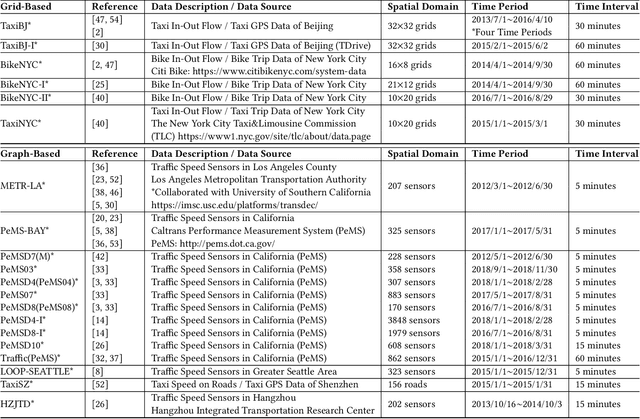
Abstract:Nowadays, with the rapid development of IoT (Internet of Things) and CPS (Cyber-Physical Systems) technologies, big spatiotemporal data are being generated from mobile phones, car navigation systems, and traffic sensors. By leveraging state-of-the-art deep learning technologies on such data, urban traffic prediction has drawn a lot of attention in AI and Intelligent Transportation System community. The problem can be uniformly modeled with a 3D tensor (T, N, C), where T denotes the total time steps, N denotes the size of the spatial domain (i.e., mesh-grids or graph-nodes), and C denotes the channels of information. According to the specific modeling strategy, the state-of-the-art deep learning models can be divided into three categories: grid-based, graph-based, and multivariate time-series models. In this study, we first synthetically review the deep traffic models as well as the widely used datasets, then build a standard benchmark to comprehensively evaluate their performances with the same settings and metrics. Our study named DL-Traff is implemented with two most popular deep learning frameworks, i.e., TensorFlow and PyTorch, which is already publicly available as two GitHub repositories https://github.com/deepkashiwa20/DL-Traff-Grid and https://github.com/deepkashiwa20/DL-Traff-Graph. With DL-Traff, we hope to deliver a useful resource to researchers who are interested in spatiotemporal data analysis.
 Add to Chrome
Add to Chrome Add to Firefox
Add to Firefox Add to Edge
Add to Edge